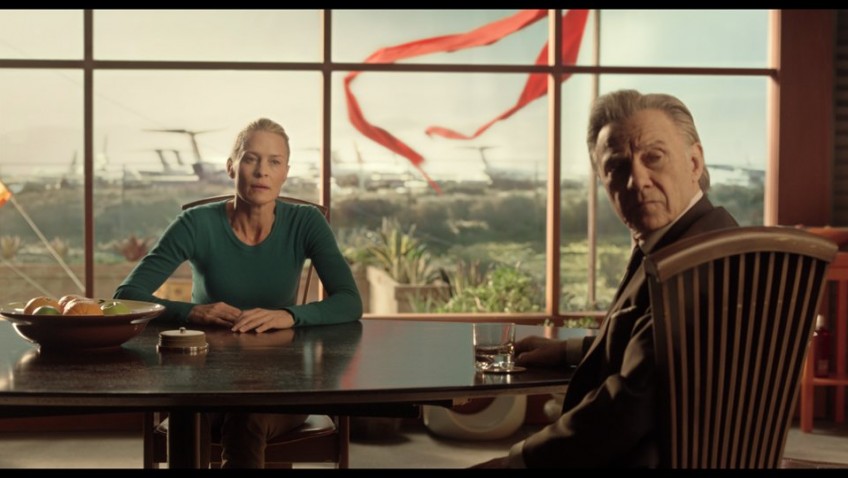The astonishingly powerful and politically-charged animation that contributed to a string of awards and nominations for Writer/ Director/ Producer Ari Folman’s Waltz with Bahshir is here replaced, by a different style of animation that takes over in the second half of Folman’s English language Sci-Fi feature, The Congress. And that’s when it all goes terribly wrong.
The first half of The Congress is a promising, live action drama about ageism in the movie business and the very future of acting now that technology enables filmmakers to scan real actors and manipulate them by computer. The problem is that this has little to do with the novel by Stanislaw Lem that Folman adapts in the second, animated, half of the film.
The Congress begins with a close up of a beautiful woman in her early 40s, Robin Wright (Robin Wright), with tears her eyes. Once upon a time she was a hot actress, and her loyal septuagenarian agent, Al (Harvey Keitel), is now telling her some hard truths. Her son’s illness is just an excuse, he tells her, referring to Aaron (Kodi Smit McPhee), who is suffering from a degenerative disease that ends in blindness and deafness.
‘Studios came crawling,’ he reminds her, but Robin has made ‘lousy choices in films’ in men, in friends and even in her mother. Al tells her that the studio’s offer is final and ‘they won’t be coming back,’ referring to an offer for money she has continually rejected. Wright agrees to go along to the interview with the number-crunching, cynical CEO of Miramount Studios, Jeff Green, (Danny Houston). He is even crueler than Al.
Robin, famous for the Princess Bride and Forest Gump (he does not mention her recent success in television’s House of Cards) is, Jeff insinuates, a has-been. Miramount is prepared to offer Robin ‘the last contract you’ll ever have’. When Robin retorts, ‘I’m not even 45’, Jeff tells her that the whole structure of cinema is changing. The studio will pay her a generous lump sum for the future rights to use her scanned, digitized image, in any way they wish for 20 years.
‘Not in Sci-Fi movies,’ she protests, resigned to accept the offer to pay for Aaron’s medical condition. The irony is, of course, that the remainder of the film is a Sci-Fi fantasy foreign to Wright’s CV. Twenty years later Robin, now in her 60s, attends Miramount’s Congress, and comes face to face with her screen character, an image that is now idolized as a goddess.
One man, who not only idolizes her, but has fallen in love with her, is the animator Dylan – portrayed by the voice and younger scanned body of a Mad Men’s Jon Hamm. Dylan has worked with Robin’s computerized image in countless films over the last 20 years and no one knows her better.
Although Robin’s contract has expired, she pays the price for trying to speak out at the Congress, her speech attracting a hidden army of rebels. She is appalled by Miramount’s new technology that allows people to become the movie character they want to be with the help of illusory drugs. Upon meeting his idol, Dylan wants to help Wright escape. But when rebels attack the Congress, things only get worse and she is confined to a mental hospital. During this time Aaron gives up hoping his mother will return to real life and enters the new, drug-induced virtual world. Will Dylan succeed in helping Robin escape her illusory life and be reunited with Aaron?
Folman explains that Lem’s novel is a cold war allegory of life under Communism, although it is curious that the chemical dictatorship of Because these drug companies have the power to control emotions, just as film studios can control our emotions, Folman had the idea of combining the two in his adaptation. The allegory does not quite fit, however, because fifty years on, the studios are more interested in controlling piracy than our emotions.
It is not the dwindling power of film studios, but the cult of celebrity from reality television, Selfies, Twitter and You Tube that is turning young minds into fantasy worlds. The scary step, introduced by the film, is that people would lock themselves into fantasy worlds for ever with a swig of prescription drugs far more potent that what is already on offer.
After deviating significantly from the novel in the first half of the film, Folman returns to it too late to unite the two stories. Numerous ideas are bombarding us without a strong dramatic narrative to support and develop them. The result is a tediously incomprehensible second hour that will hardly help restore our faith in the power of good, old fashioned cinema.
Joyce Glasser – MT film reviewer




